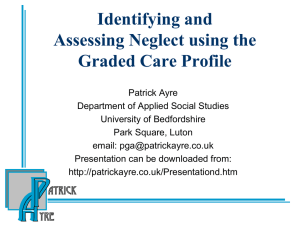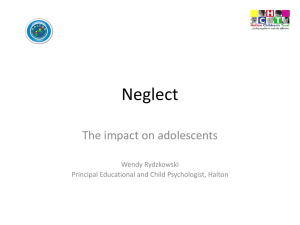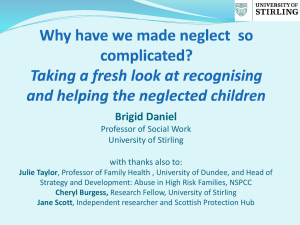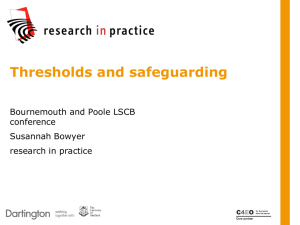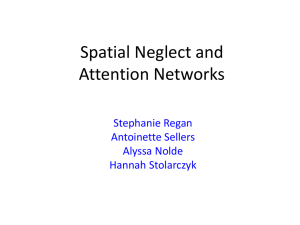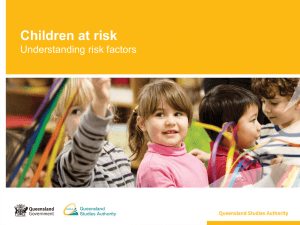Assessing Neglect Workshop (Bridgend)
advertisement
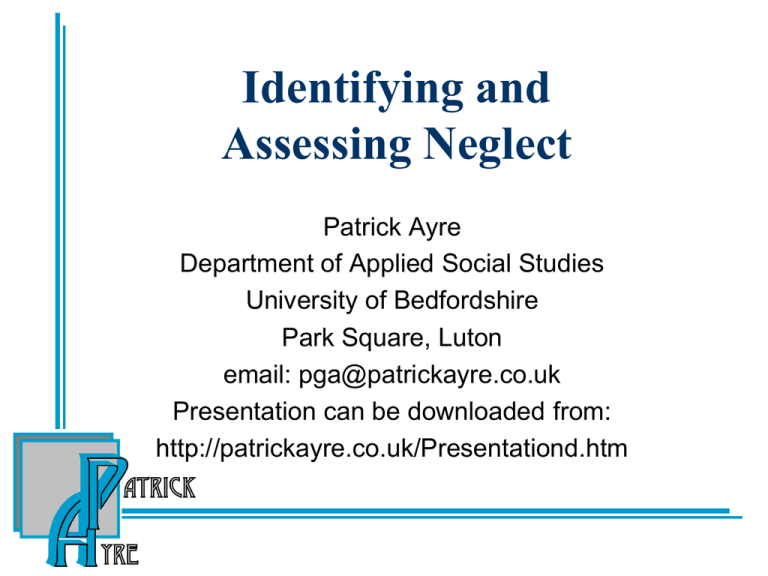
Identifying and Assessing Neglect Patrick Ayre Department of Applied Social Studies University of Bedfordshire Park Square, Luton email: pga@patrickayre.co.uk Presentation can be downloaded from: http://patrickayre.co.uk/Presentationd.htm NEGLECT Parents who neglect their children basically just don’t know any better because of their own poor upbringings. If we send them to a family centre for Parental Skills training, all will be well. NEGLECT Parents who neglect their children basically just don’t know any better because of their own poor upbringings. If we send them to a family centre for Parental Skills training, all will be well. IF ONLY!!.... NEGLECT So neglected children who come into care may be a bit thin, a bit dirty, badly in need of seeing a doctor or dentist, maybe a bit wild. But we can place them with foster carers for a bit of looking after, a bit of TLC, a bit of structure and everything will be fine. The children will absolutely love it and will immediately start to thrive. Simple really! NEGLECT So neglected children who come into care may be a bit thin, a bit dirty, badly in need of seeing a doctor or dentist, maybe a bit wild. But we can place them with foster carers for a bit of looking after, a bit of TLC, a bit of structure and everything will be fine. The children will absolutely love it and will immediately start to thrive. Simple really! IF ONLY!!.... Brain development By the age of 3, a baby’s brain has reached almost 90 percent of its adult size. The growth in each region of the brain largely depends on receiving stimulation. This stimulation provides the foundation for learning. Experience Affects the Structure of the Brain Brain development is “activitydependent” Every experience excites some neural circuits and leaves others alone Neural circuits used over and over strengthen, those that are not used are dropped resulting in “pruning” Poor integration of hemispheres and underdevelopment of the orbitofrontal cortex Difficulty regulating emotion, Lack of cause-effect thinking, Inability to recognize emotions in others, Inability to articulate own emotions, Incoherent sense of self and autobiographical history Lack of conscience. Other physiological issues Serotonin: emotional stability and feeling good Malnutrition: cognitive and motor delays, anxiety, depression, social problems, and attention problems Myelination Sensitive periods (infancy & attachment) Emotional development Sensitive period for emotional development: up to 18 months Shaped primarily by the way in which the prime carer interacts with the child Emotional deficits harder to overcome once the sensitive window has passed. How often do we intervene assertively at this point? Building a child Building a child is like building a house, each new level built on the one below. If the lower levels are unsound, no amount of tinkering with the upper floors will make it stable. Capturing chronic abuse Single events often only significant in context; Can often only understand present by setting in context of past Intangible: Difficult to capture and compare High threshold for recognition Neglect is a pattern not an event The pattern of neglect: atypical The pattern of neglect Intervention Intervention The pattern of neglect 'Good enough' level Intervention Intervention The pattern of neglect Intervention ceases 'Good enough' level Intervention Intervention The pattern of neglect Cumulativeness S E X U A L A B U S E P H Y S I C A L A B U S E N E G L E C T N E G L E C T N E G L E C T Threshold for intervention Failure of cumulativeness S E X U A L A B U S E Threshold for intervention P H Y S I C A L A B U S E N E G L E C T N E G L E C T N E G L E C T N E G L E C T What’s the problem? Chronic abuse and the principle of cumulativeness Files very long and badly structured Patterns missed and ‘chronic abuse’ overlooked The problem of proportionality Acclimatisation (case, agency and geographical) Why do parents neglect? We need to understand the interaction between: 3 Ns: Nurture, Nature, Now Circumstantial factors and fundamental factors Why do parents neglect? Circumstantial Poverty Particular relationships Lack of skill/knowledge Temporary illness Lack of support Environmental factors Fundamental Lack of parenting capacity Deep seated attitudinal/behavioural/ psychological problems Long term health issues Entrenched problematical drug /alcohol use The effects of neglect Howe identifies 4 types of neglect Emotional neglect Disorganised neglect Depressed or passive neglect Severe deprivation Each is associated with different effects and implications for intervention Emotional neglect Sins of commission and omission ‘Closure’ and ‘flight’: avoid contact, ignore advice, miss appointments, deride professionals, children unavailable However, may seek help with a child who needs to be ‘cured’ Intervention often delayed Emotional neglect: parents Can’t cope with children’s demands: avoid/disengage from child in need; dismissive or punitive response Six types of response: – Spurning, rejecting, belittling – Terrorising – Isolating from positive experiences – Exploiting/corrupting – Denying emotional responsiveness – Failing medical needs Emotional neglect: children Frightened, unhappy, anxious, low self-esteem Precocious, ‘streetwise’ Withdrawn, isolated, aggressive: fear intimacy and dependence Behaviour increasingly anti-social and oppositional Brain development affected: difficulties in processing and regulating emotional arousal Disorganised neglect Classic ‘problem families’ Thick case files Can annoy and frustrate but endear and amuse Chaos and disruption Reasoning minimised, affect is dominant Feelings drive behaviour and social interaction Disorganised neglect: carers Feelings of being undervalued or emotionally deprived in childhood so need to be centre of attention/affection Demanding and dependant with respect to professionals Crisis is a necessary not a contingent state Disorganised neglect: carers Cope with babies (babies need them) but then… Parental responses to children unpredictable; driven by how the parent is feeling, not the needs of the child Lack of ‘attunement’ and ‘synchronicity’ Disorganised neglect: children Anxious and demanding Infants: fractious, fretful, clinging, hard to soothe Young children: attention seeking; exaggerated affect; poor confidence and concentration; jealous; show off; go to far Teens: immature, impulsive; need to be noticed leads to trouble at school and in community Neglectful parents feel angry and helpless: reject the child; to grandparents, care or gangs Depressed neglect Classic neglect Material and emotional poverty Homes and children dirty and smelly Urine soaked matresses, dog faeces, filthy plates, rags at the windows A sense of hopelessness and despair (can be reflected in workers) Depressed neglect: carers Often severely abused/neglected: own parents depressed or sexually or physically abusive May have learning difficulties Passive helplessness response to demands of family life Have given up both thinking and feeling Depressed neglect: carers Listless and unresponsive to children’s needs and demands, limited interaction Lack of pleasure or anger in dealings with children and professionals No smacks, no shouting, no deliberate harm but no hugs, no warmth, no emotional involvement No structure; poor supervision, care and food Depressed neglect: children Lack interaction with parents required for mental and emotional development Infant: Incurious and unresponsive; moan and whimper but don’t cry or laugh At school: isolated, aimless, lacking in concentration, drive, confidence and selfesteem but do not show anti-social behaviour Severe deprivation Eastern European orphanages, parents with serious issues of depression, learning disabilities, drug addiction, care system at its worst Children left in cot or ‘serial caregiving’ Combination of severe neglect and absence of selective attachment: child is essentially alone Severe deprivation: children Infants: lack pre-attachment behaviours of smiling, crying, eye contact Children: impulsivity, hyperactivity, attention deficits, cognitive impairment and developmental delay, aggressive and coercive behaviour, eating problems, poor relationships Inhibited: withdrawn passive, rarely smile, autistic-type behaviour and self-soothing Disinhibited: attention-seeking, clingy, overfriendly; relationships shallow, lack reciprocity The assessment of neglect An approach based on the Graded Care Profile by Dr OP Shrivastava GCP provides: Framework for making assessment Baseline measurement An element of objectivity Judgement about care Reliable standardised evidence http://www.lutonlscb.org/index.php?option=com_content&view=article&id= 183&Itemid=52 GCP users Health visitors School nurses Social workers Family centre workers Education welfare workers GCP uses Pre-referral assessments Snapshot assessments Contribution to CAF assessments Contribution to Core Assessment (parenting capacity) Self-assessment (parents and carers) Young person’s assessment of parenting Tool for setting goals and assessing progress Tool to facilitate discussion Domains of Care Stimulation Sensitivity Responsivity Self actualisation Reciprocity Overtures Esteem Love and belongingness Safety Approval Disapproval Acceptance Present & absent Physical needs Maslow, A. 1954 Nutrition. Housing, Clothing, Hygiene & Health What to observe A. PHYSICAL B. SAFETY Nutrition Quality, Housing Quantity, Clothing Preparation, Hygiene Organisation, Health C. LOVE D. ESTEEM Grades of Care Grade 1 Grade 2 Grade 3 Grade 4 Grade 5 Level of care All child’s Essential needs met needs fully met Some essential needs met Most essential needs unmet Essential needs entirely unmet/hostile Commitment to care Child first Child priority Child/carer at par Child second Child not considered Quality of care Best Adequate Equivocal Poor Worst Example: AREA C: LOVE Sub-areas 1 2 3 4 5 Comprehends clear signals – distinct verbal or clear nonverbal expression. Not sensitive enough – stimuli and signals have to be intense to make an impact e.g. cry. Quite insensitive – needs repeated or prolonged intense signals. Insensitive to even sustained intense signals or aversive. Responses mostly synchronised except when occupied by essential chores. Not synchronised Even when child in for own distress responses recreational delayed. engagement; synchronised if fully unoccupied or child in distress. No responses unless a clear mishap for fear of incrimination. Material responses (treats etc.) lacking, but emotional responses warm and reassuring. Emotional reciprocation warm if in good mood (not burdened by strictly personal problem), otherwise flat. Aversive/punitive even if child in distress, acts after a serious mishap mainly to avoid incrimination, any warmth/remorse deceptive. 1. Carer A Anticipates or picks Sensitivity up very subtle signals- verbal or nonverbal expression or mood. B Responses well Response synchronised with Synchronisation signals or even before in Timing anticipation C Responses Reciprocation complementary to (quality) the signal. Both emotionally and materially, can get over stressed by distress signals from child. Warm. Emotional reciprocation brisk, flat and functional, annoyance if child in moderate distress but attentive if in severe distress. Sub-Area Scores 1. NUTRITION 1 2 3 4 5 2. HOUSING 1 2 3 4 5 3. CLOTHING 1 2 3 4 5 4. HYGIENE 1 2 3 4 5 5. HEALTH 1 2 3 4 5 (B) Safety 1. IN CARER’S PRESENCE 1 2 3 4 5 2. IN CARER’S ABSENCE 1 2 3 4 5 (C) Love 1. CARER 1 2 3 4 5 2. MUTUAL ENGAGEMENT 1 2 3 4 5 1. STIMULATION 1 2 3 4 5 2. APPROVAL 1 2 3 4 5 3. DISAPPROVAL 1 2 3 4 5 4. ACCEPTANCE 1 2 3 4 5 (A) Physical (D) Esteem Area Score Comments Targeting Items of Care Targeted Areas 1 2 3 4 5 Current Score Target Score Timescale Reviewed Score Making an assessment Guidance provided (follow up scores of 4 or 5) Evaluates strengths as well as weaknesses Allows progress to be assessed A relatively objective measure Allows help to be targeted where needed Making an assessment Common language, common reference Objective measure – child focussed Effective tool to promote partnership assessments and planning with parents User friendly Comprehensively covers all areas of care Child and carer specific Scale for Assessing Neglectful Parenting (Northamptonshire) 179 individual questions under the following headings: Food and Eating Habits Health and Hygiene Warmth/Clothing Safety and Supervision Emotional Needs Cognitive Development Educational Needs http://northamptonshirescb.proceduresonline.com/chapters/p_lscbn _neg.html Example questions (Health and Hygiene) 21 The home lacks showering or bathing facilities which work, and are available for maintaining personal hygiene 22 The bath and basin are dirty, or inaccessible 23 The family lacks a toilet which works 24The toilet is regularly left dirty or stained 25 Toddler’s potties are left unemptied containing urine and faeces 26 The kitchen is dirty (eg cooker ingrained with old food, grime on walls, floor, kitchen utensils, sink) Making an assessment Each statement scored 1, 2 or 3 according to how true it is. Blank spaces for Summary, Conclusions and Action Plan Lengthy and comprehensive list of relevant factors No guidance on making overall judgments Statements all identify weaknesses Allocation of questions to headings a little eccentric at times The chain of reasoning Facts Analysis/summary Conclusions/recommendations/action The chain of recording What happened/what you saw What this means What you did/what should be done (and why, if this is not clear from the above) The chain of recording But how do you know which facts? Must be informed by a basic risk assessment (would not always be spelled out on paper) Risk assessment The dangers involved (that is the feared outcomes); The hazards and strengths of the situation (that is the factors making it more or less likely that the dangers will realised); The probability of a dangerous outcome in this case (bearing in mind the strengths and hazards); The further information required to enable this to be judged accurately; and The methods by which the likelihood of the feared outcomes could be diminished or removed. Bias and Balance Include information favourable to ‘the other side’ as well as that favourable to yours It is your job to make judgements but: – avoid empty evaluative words like inappropriate, worrying, inadequate – Give evidence for descriptive words like cold, dirty and untidy Beware the danger of facts Bias and Balance Born in 1942, he was sentenced to 5 years imprisonment at the age of 25. After 5 unsuccessful fights, he gave up his attempt to make a career in boxing in 1981 and has since had no other regular employment Lies, damned lies and killer bread Research on bread indicates that More than 98 percent of convicted felons are bread users. Half of all children who grow up in bread-consuming households score below average on standardized tests. More than 90 percent of violent crimes are committed within 24 hours of eating bread. Primitive tribal societies that have no bread exhibit a low incidence of cancer, Alzheimer's, Parkinson's disease, and osteoporosis. In the 18th century, when much more bread was eaten, the average life expectancy was less than 50 years; infant mortality rates were unacceptably high; many women died in childbirth; and diseases such as typhoid, yellow fever, and influenza were common. Incomplete or out of date Can you trust a snapshot? Assessment Pitfalls Parents’ behaviour, whether co-operative or uncooperative, often misinterpreted Information from family friends and neighbours undervalued Coping with aggressive or frightening families Failure to give sufficient weight to relevant case history; ‘Start again syndrome’ Not enough attention is paid to what children say, how they look and how they behave; maintenance of a wholly child-centred approach A child centred approach The purpose of assessment is to understand what it is like to be that child (and what it will be like in the future if nothing changes) Information handling pitfalls Picking out the important from a mass of data Facts recorded faithfully but not always critically appraised Too trusting/insufficiently critical; Decoyed by another problem False certainty; undue faith in a ‘known fact’ Discarding information which does not fit the model we have formed Department of Health (1991) Child abuse: A study of inquiry reports, 1980-1989, HMSO, London Assessment pitfalls Rule of optimism Natural love Cultural relativism Too much not enough Information handling pitfalls Keeping your head down Hesitancy to challenge other professionals or the conventional wisdom Tendency to move from facts to actions without ‘showing your working’ But what is analysis? You have gathered lots of information but now what? All you need to do is ask yourself my favourite question: “So what?” You have collected all this data, but what does this mean, for the service user, for the family and for my setting? Conclusions and recommendations Summarise the main issues and the conclusions to be drawn from them. (The facts do not necessarily speak for themselves; it is your job to speak for them.) Define objectives as well as actions Draw conclusions from the facts and recommendations from the conclusions Explain how you arrived at your conclusions (Have you demonstrated the factual/theoretical basis for each?) Consider and discuss alternative possibilities Conclusions and recommendations In drawing conclusions be aware of the extent and limitations of your own expertise. Conclusions may be supported by research (Don’t go outside expertise; be careful with new or controversial theories; be aware of counter arguments) Your recommendation should usually be specific (not either/or) Remember: conclusions may be attacked in only two ways – founded on incorrect information – based on incorrect principles of social work Conclusions and recommendations Problems: Unsupported assertions or judgements Inability or unwillingness to analyse and draw conclusions Failure to answer the key question: ‘So what?’ Reaching a decision ‘Often a decision is made first and the thinking done later’ (Thiele, 2006) As humans, we resort to simplifications, short cuts and quick fixes! We reframe, interpret selectively and reinterpret. We deny, discount and minimise We exaggerate information especially if vivid, unusual, recent or emotionally laden and We avoid, forget and lose information Good Assessments Are clear about the purpose, legal status and potential outcomes Are based on a clear theoretical framework Are clear about context and value base Are collaborative and promote accessibility for service users Are based on multiple sources of information Value the expertise and understanding service users bring to their situation Are clear about missing information Good Assessments Identify themes and patterns about needs, risks, protective factors and strengths Generate and test different ways of understanding the situation Give meaning to themes, using knowledge based on experience/research Lead to an evidence-based conclusion Use supervision to assist reflection, hypotheses and objectivity Are able to record and explain outcomes Are reviewed, updated & amended in light of new information Spotting the bad ones: Organisational Clues Mythology exists about the family – ‘this family is/always/behaves like Negative stereotypes about other agencies exist so their information is discounted Sudden changes about view of risk not explained Sudden changes of plan not rationally explained Worker clues Gut feelings says something is wrong Worker does not ask difficult questions Analysis does not account for facts/history Proposed plan does not address issues raised in assessment Practitioner is working much harder than the parents to explain significant concerns The child’s story is missing Inter-Agency Clues Agencies have conflicting views of the family/risk Agencies have strong views but offer ambiguous/limited evidence Some agencies unwilling to share information Pressure to agree suppresses permission to question / inter-agency acclimatisation Family Clues Parental intentions not supported by actions Parental optimism involves denial of difficulties Children's accounts conflict with parents’ Parents’ ‘talk’ about their child is contradictory/lacks coherence Co-operation is only on the parents’ terms A final thought “We are guilty of many errors and many faults but the worst of our crimes is abandoning our children, neglecting the fountain of life. Many of the things we need can wait. The child cannot. Right now is the time his bones are being formed, his blood is being made, and his senses are being developed. To him we cannot answer 'Tomorrow.' His name is 'Today.'” Gabriela Mistral (Chilean poet, 1889-1957)
